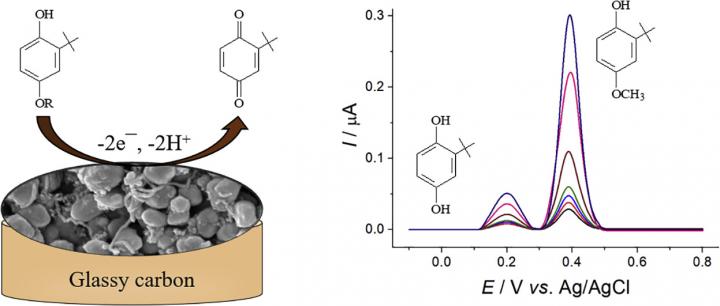A paper by Kazan Federal University appeared in Journal of Electroanalytical Chemistry

Credit: Kazan Federal University
Antioxidants are one of the most interesting and widely investigated compounds in life sciences due to their key role in the protection of living systems from the negative effects of free radicals. A great variety of antioxidants and discoveries of new ones give opportunities to better understand their pathways and mechanisms of action. Furthermore, evaluation of the ratios of antioxidants in different samples (foods, herbs, pharmaceuticals, biological fluids, etc.) helps quality control and predicting of possible health effects. Guzel Ziyatdinova and her colleagues at Kazan Federal University have been working on this topic for nearly 20 years.
Among a wide range of antioxidants, synthetic phenolic antioxidants and, in particular, sterically hindered phenols are of much practical interest. They are used as a food antioxidant additives for oily and fatty products in order to prevent oxidative rancidity. The most common preserving additives of this type are tert-butylhydroquinone (TBHQ), butylated hydroxyanisole (BHA) and butylated hydroxytoluene. Nevertheless, their quantity in food is strictly regulated because high concentrations lead to negative health effects like chronic neurotoxicity, vision impairment, carcinogenesis, and underdevelopment of the reproductive system. Mixtures of additives are applied as well, and their ratios in products are varied. Therefore, sensitive and selective methods for the simultaneous determination of these antioxidants are required.
The presence of phenolic fragment in the structure of compounds under investigation makes them oxidizable under different conditions, including electrochemical oxidation. Therefore, methods of electroanalysis can be applied for the determination of sterically hindered phenols. The main advantages of electroanalysis over other analytical tools are high sensitivity and selectivity, rapid response, simplicity and cost-efficiency, as well as capacity for miniaturization.
Due to their structural similarity, TBHQ and BHA are usually oxidized at close potentials, rendering it impossible to determine them simultaneously. In this research, a novel amperometric sensor has been developed for this purpose. It is based on glassy carbon electrode covered with multi-walled carbon nanotubes and electropolymerized carminic acid as the sensitive layer. Carminic acid – a natural dye – was used as a monomer for the first time. Poly(carminic acid) was obtained by electrochemical potential cycling. Attention was paid to the conditions of electro-polymerization (monomer concentration, supporting electrolyte pH, number of cycles and electrolysis parameters) that strongly affect the properties of polymeric coverage and, consequently, the voltammetric response of target compounds.
Both TBHQ and BHA are oxidized on the sensor surface at relatively low anodic potentials, which reduces the interference effect from other electroactive compounds. The combination of electrode surface modifiers (carbon nanotubes and polymeric layer) provides improvements in the voltammetric response of TBHQ and BHA and good resolution of their oxidation peaks in simultaneous presence, as far as oxidation of the phenols proceeds independently, in contrast to strong overlapping of the oxidation peaks occurring at the unmodified glassy carbon electrode. The sensor is selective to TBHQ and BHA in the presence of inorganic ions, ascorbic acid, and α-tocopherol.
Sensor characteristics are significantly improved or comparable with those reported earlier for another modified electrodes. The advantages of this sensor are also the simplicity and rapidity of its preparation, as well as higher selectivity of TBHQ and BHA quantification in comparison to other amperometric sensors.
The sensor has been successfully tested on linseed oils. TBHQ and BHA have been extracted by ultrasonic-assisted extraction with ethanol. The recovery values confirm high accuracy of the TBHQ and BHA determination, the absence of the matrix effects, and the applicability of the sensor to real samples.
Thus, poly(carminic acid) based sensors can be used for the control of the quality and safety of edible oils.
The investigation confirmed that electrodes modified with electropolymerized dyes can be used for the determination of structurally similar compounds, including antioxidants. Further findings can be focused of the enlargement of the dyes forming non-conductive polymers in combination with conductive nano materials as electrode surface modifiers. On the other hand, the study of another types of structurally similar antioxidants used in food industry or being a part of daily human diet is also of practical interest. This problem in electroanalysis can be solved using the aforementioned approaches. In general, such kind of investigations will enlarge the application area of electrochemical methods in the routine practice of sample screening as a good alternative to other analytical methods, including chromatography.
###
Media Contact
Yury Nurmeev
[email protected]
Original Source
https:/
Related Journal Article
http://dx.





